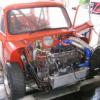
Headlight Switch Getting So Hot You Cant Touch It!
#1

Posted 22 October 2009 - 04:24 PM
1989
I have a fairly serious problem that I cant figure out, my headlight switch gets so hot that you cant even touch it.
If you turn turn side lights on it seems to be fine (gets luke warm but nothing I wouldnt expect), if however you turn the headlights on you can instantly feel the rear of the switch and the white plug getting hotter and hotter, after about 15mins you cant touch it and there is a distinct smell of hot plastic (I haven't let it get to the point of burning yet!). Obviously the heat is transfered down the wires and these get just as hot. If I remove the switch the bottom pin out of the 3 is the hottest and gives off some serious heat!
I am wondering what this could possibly be? The lights have been run through a fuse and the fuse is the right rating and seems fine. All the other electrics are working as they should be as far as I am aware.
Can anyone help??
#2

Posted 22 October 2009 - 04:34 PM
Minis of that era, right up to the introduction of the MPi have a serious flaw in the electrical system in that the headlamp switch is very close to its maximum rating when all the lamps are lit. The switch is rated at 16 amps and the standard system draws something like 14.7. Add 20 years of corrosion to the wiring loom and all the connectors (corrosion draws current) and the system is out of spec. If you add anything to this such as halogen headlamps, extra gauges with internal lighting, even a radio that connects to the lighting circuit, literally anything the switch gets hot. If the corrosion is really bad it can overload all by itself without you adding anything. You say the lamps are running through a fuse but which lamps are you talking about? As standard only the sidelights run through a fuse. It doesn't matter if the fuse is the right rating, there are several circuits running on this switch and just because each individual circuit is within its own tollerance doesn't mean the switch can handle the total load of all the circuits added together. The best solution to this is to fit relays for your main and dip beam headlamps so that the load of these (the biggest single load on the system) is removed from the switch. You should also replace the switch and its connector, chopping back as much of the loom as you can get away with and still have the connector reach the switch panel. Open up the loom for a short distance from the connector back to see how far any damage extends.
#3

Posted 23 October 2009 - 04:12 PM
Thanks for such an in depth reply!
In answer to you question, the main lights are also fused on a separate fuse box. I installed a second box to handle extras such as stereo and CB save chopping/overloading the main fuses/wiring loom.
I didnt realise that the load was so high on the switch. I do have halogen headlamps but nothing else running off the light circuit other than the standard so I presume there is a fair bit of corrosion somewhere.
The loom is pretty tight on the switch as it is so I presume some of it has already been chopped away. I will see how easy it is to replace as much of the wiring as I can to the lights.
Do you know if there are higher rated switches around to the standard mini spec?
Thanks again for your in depth help!
#4

Posted 23 October 2009 - 04:19 PM
I did mine like this

#5

Posted 23 October 2009 - 04:47 PM
This is a very common problem and there are already many threads about it.
Minis of that era, right up to the introduction of the MPi have a serious flaw in the electrical system in that the headlamp switch is very close to its maximum rating when all the lamps are lit. The switch is rated at 16 amps and the standard system draws something like 14.7. Add 20 years of corrosion to the wiring loom and all the connectors (corrosion draws current) and the system is out of spec. If you add anything to this such as halogen headlamps, extra gauges with internal lighting, even a radio that connects to the lighting circuit, literally anything the switch gets hot. If the corrosion is really bad it can overload all by itself without you adding anything. You say the lamps are running through a fuse but which lamps are you talking about? As standard only the sidelights run through a fuse. It doesn't matter if the fuse is the right rating, there are several circuits running on this switch and just because each individual circuit is within its own tollerance doesn't mean the switch can handle the total load of all the circuits added together. The best solution to this is to fit relays for your main and dip beam headlamps so that the load of these (the biggest single load on the system) is removed from the switch. You should also replace the switch and its connector, chopping back as much of the loom as you can get away with and still have the connector reach the switch panel. Open up the loom for a short distance from the connector back to see how far any damage extends.
Some of the above dosen't really make sense to me, why does corrosion draw current?
Halogen conversions are the main culpret along with worn switches would be my thoughts. a new switch should go some way to help.
#6

Posted 23 October 2009 - 06:01 PM
#7

Posted 23 October 2009 - 06:23 PM
This is a very common problem and there are already many threads about it.
Minis of that era, right up to the introduction of the MPi have a serious flaw in the electrical system in that the headlamp switch is very close to its maximum rating when all the lamps are lit. The switch is rated at 16 amps and the standard system draws something like 14.7. Add 20 years of corrosion to the wiring loom and all the connectors (corrosion draws current) and the system is out of spec. If you add anything to this such as halogen headlamps, extra gauges with internal lighting, even a radio that connects to the lighting circuit, literally anything the switch gets hot. If the corrosion is really bad it can overload all by itself without you adding anything. You say the lamps are running through a fuse but which lamps are you talking about? As standard only the sidelights run through a fuse. It doesn't matter if the fuse is the right rating, there are several circuits running on this switch and just because each individual circuit is within its own tollerance doesn't mean the switch can handle the total load of all the circuits added together. The best solution to this is to fit relays for your main and dip beam headlamps so that the load of these (the biggest single load on the system) is removed from the switch. You should also replace the switch and its connector, chopping back as much of the loom as you can get away with and still have the connector reach the switch panel. Open up the loom for a short distance from the connector back to see how far any damage extends.
Some of the above dosen't really make sense to me, why does corrosion draw current?
Halogen conversions are the main culpret along with worn switches would be my thoughts. a new switch should go some way to help.
When wires corrode the resistance of the wires increases. Also, they can handle less current draw. So rather than corrosion drawing current its maybe a case of corrosion effectivly lowers the rating of the system. I know what i mean, but I find these things hard to explain
#8

Posted 24 October 2009 - 08:01 AM
#9

Posted 24 October 2009 - 01:35 PM
The suggested relays will really address this. The schematic provided above is great. The terminal numbers shown on it are for the Bosch/ISO relays you will find almost everywhere. They are excellent for this purpose. Fit the relays as shown above and the load on your switch will be so significantly reduced that you won't have to replace it.
In response to the question about relays making headlights brighter, they can. In general when relays are installed, shorter lengths of heavy gauge wires with dedicated inline fuses are used. With shorter lengths of heavy gauge wire and no corrosion on the new connections or relay contacts... there is less voltage drop to the headlights and they generally burn brighter.
#10

Posted 24 October 2009 - 01:50 PM
In response to the question about relays making headlights brighter, they can. In general when relays are installed, shorter lengths of heavy gauge wires with dedicated inline fuses are used. With shorter lengths of heavy gauge wire and no corrosion on the new connections or relay contacts... there is less voltage drop to the headlights and they generally burn brighter.
Thanks for explaining that mate. Where would I have to use the shorter heavy gauge wire and inline fuses? I was thinking about upgrading the dipped. main and earth wires to heavier gauge wire and shortening the earth wires and doing away with those headlamp loom connectors behind the grille. Would I see any benefit from doing this as well as installing relays into the circuit?
Ta (and apologies for the hijack
mike
#11

Posted 24 October 2009 - 02:04 PM
Refer back to the schematic posted above. The practice I'm familiar with is to make a relay panel and mount it in the engine bay somewhere near the starter solenoid but not exposed to road spray. The power is taken from a connection directly on the solenoid's "hot" terminal. (This is equivalent to what the schematic above says as "to + battery positive). The schematic above shows fusible links, I used inline fuses. Regardless, this gives your new heavy gauge wires and inline fuses a connection directly to the car's main power. The only power flowing through the car's old loom will be around 90 mA to trigger the relays. This is a significant reduction on the load the switch deals with.
#12

Posted 24 October 2009 - 02:08 PM
Mike
#13

Posted 29 March 2012 - 09:56 PM
#14

Posted 30 March 2012 - 12:35 AM
http://www.autospark...roducts_id=1066, they also carry the Mini light switch. Using 2, one each for high/ low beam will also save your indicator stalk.
#15

Posted 30 March 2012 - 07:58 AM
If you want to use relays, which are quite cheap, use one for each filament, so you have two for main beam, two for dip, and either use four fusible links, one for each, or two fusible links, one feeding left main and dip, the other feeding right main and dip, so that if one fails, you only lose one light.
Oh, and as has been said, run the earths from each light seperately to earth, not the daft way Rover did it, where a single failed bullet connector again loses both lights. Earth the relays sererately too, at least seperate the left and right if you are using four.
Remember how many questions here relate to failed fuses, corroded connectors, etc, and you will see why these things really matter.
1 user(s) are reading this topic
0 members, 1 guests, 0 anonymous users



















